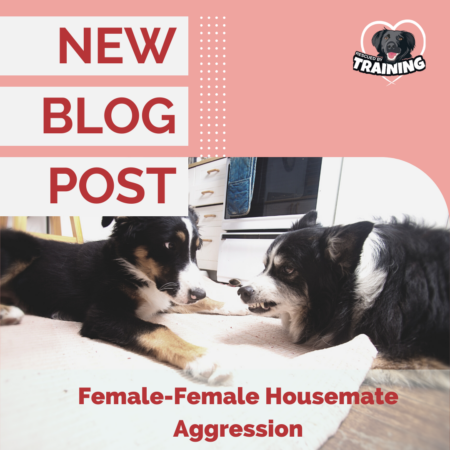A few times a year I get called in on cases of two female housemates having aggression issues. Often these dogs have lived together for a while, with sort of normal, predictable fights over resources like food, toys, resting spots or attention. But then the fights get more frequent, more intense, more injurious and less predictable. They start to spiral out of control and then owners reach out. This pattern of escalating frequency and increasing severity of fights between female housemates is serious issue and one that makes even competent applied behavior professionals like myself, cringe a little. My first question is almost always, is the younger dog between age 1-3? I commonly see female-female aggression pop out during social maturity.
Female-female housemate aggression is one of the few behavior issues we have a lack of specific research on. In these cases we need to rely heavily on strict separation, muzzle training, management and in many cases, rehoming, if the family is unable to keep both dogs safe and provide a good quality of life with these new restrictions. Qualified behavior consultants are able to modify many kinds of dog-to-dog aggression: leash reactivity, rough play, bullying, and even fear of other dogs but fights between female housemates and gameness, (selective breeding for strong propensity to fight), are two areas where there’s still a lot of gray areas on how these issue develop and how to modify them.
While is this isn’t a widely studied subject but there are some studies on dog-dog aggression that we can glean some insights from. In this study, which analyzed cases of dog-dog aggression treated at the Animal Behavior Clinic, Cornell University, the results showed “For household aggression, same-sex pairs, especially females, were far more numerous than opposite-sex pairs. Of dogs that started household fights, 58% were younger and 59% arrived in the home more recently than the target dog. Household fights were more injurious than fights with outsiders; fights between female housemates tended to be more severe than other gender combinations.”
This study showed in over 70% of cases, resource guarding was a trigger, the aggressor was acquired after the recipient in 59.3% of the cases, on average, the aggressors were 16 months younger and bites that inflicted injuries requiring vet care, resulted in poorer outcomes for behavior modification.
And this study showed 79% of cases of dog-dog household aggression involved same-sex pairs, 68% of which were female-female or involved one female. 74% of instigators were the younger of the pair or new additions to the household (70%). “Fight-eliciting triggers included owner attention, food, excitement, and found items.”
Due to the injury risks involved, both to the dogs and to the humans trying break up fights, the unpredictable nature of these fights, and the emotional toll it takes on the family, it’s incredibly important to work with a qualified behavior consultant, like myself, for guidance if you suspect you might be dealing with a female-female housemate issue.
What can you do to keep everyone safe in the meantime?
- Separate both female dogs, using physical barriers like gates or crates
- Begin muzzle training with a bite proof basket muzzle. I recommend this self-paced course.
- Increase enrichment and exercise
- Use two levels of barriers when dogs are home alone (dog in crate, in a room with the door closed, for example)
- Schedule a session with a qualified behavior consultant
If you need help not only am I a qualified behavior consultant but I am a certified end-of-life doula for companion animals, so I have specialized training in helping families navigate loss – whether from natural aging, behavioral euthanasia or rehoming. You don’t need to navigate this alone. I can provide you with guidance on what the best outcome might be in cases like this. You can schedule your session here!
Happy training!
![]()




